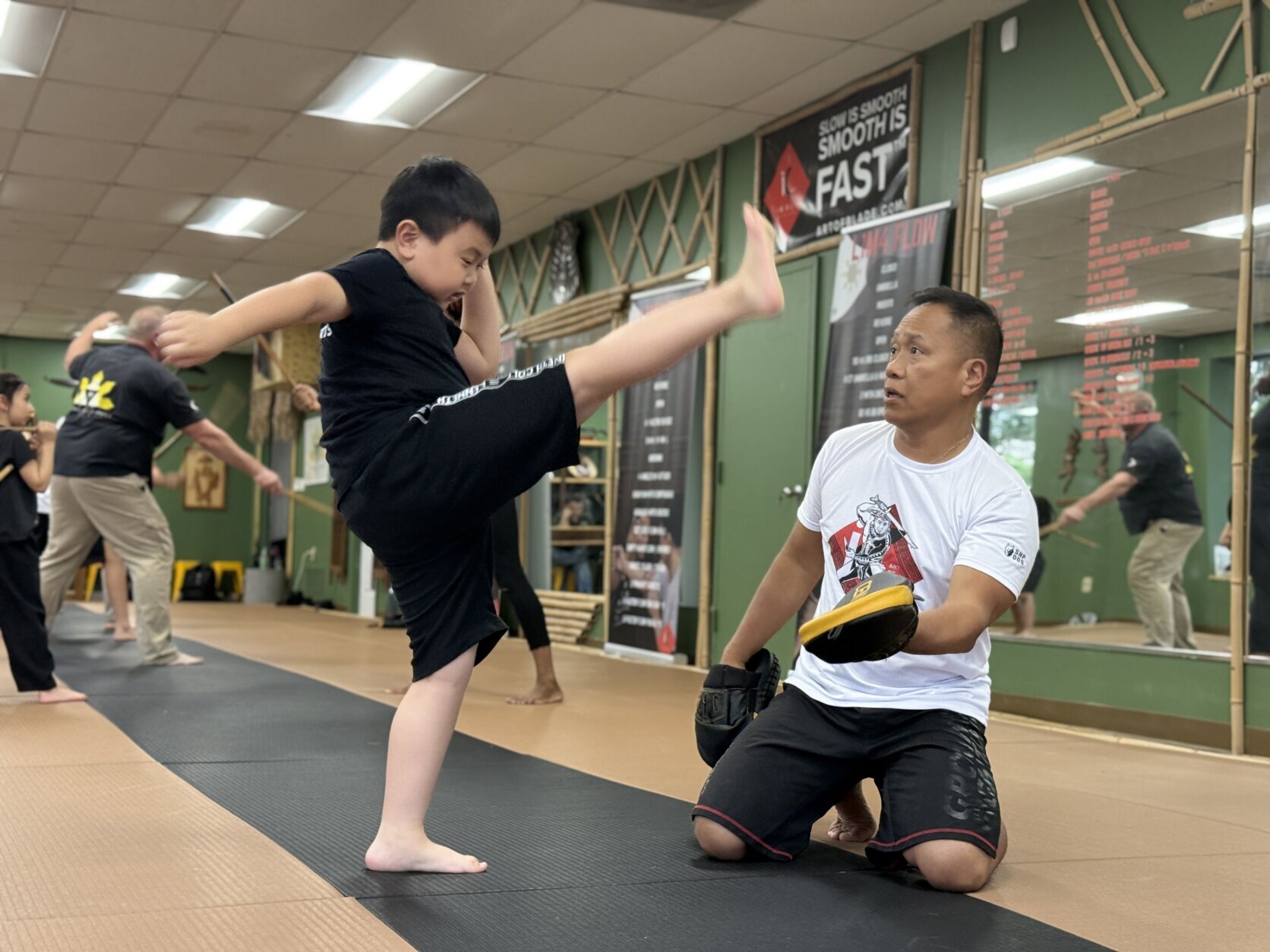
(WTOP/Luke Lukert)
WTOP/Luke Lukert

(WTOP/Luke Lukert)
WTOP/Luke Lukert

(WTOP/Luke Lukert)
WTOP/Luke Lukert

(WTOP/Luke Lukert)
WTOP/Luke Lukert

(WTOP/Luke Lukert)
WTOP/Luke Lukert

(WTOP/Luke Lukert)
WTOP/Luke Lukert
Weapons-based martial art Kali shares self defense and the culture of the Philippines
All throughout May, WTOP is celebrating Asian American and Pacific Islander Heritage Month with stories about the people and places shaping the D.C. region.
A martial arts school in Anne Arundel County, Maryland, not only teaches students self-defense, but defines the culture of the Philippines with one of its most celebrated fighting styles — kali.
Students use their fists, sticks and blades as they practice at the Filipino Kali Academy. The focus on weapons comes from the history of the Philippines during times of conflict.
“It was poor back then, so we couldn’t afford guns or anything like that. So the only thing we have a lot of is our farming tools, our gardening tools,” Apolo Ladra told WTOP in his studio in Glen Burnie.
For over an hour, students will drill with each other, throwing crossing right punches, ax and round kicks, and elbows before switching to complex movements with single and double sticks, often going over how to disarm opponents.
After the warm-ups, the training knives come out and students will grapple over knife attacks, smoothly flowing to keep the blade from stabbing and slashing.
The machetes and knives they use are similar to what was used to clear brush (bolo machetes) or harvest their crops (halves of plant clippers). The sticks commonly associated with kali and other Filipino martial arts, such as Escrima, are stand-ins for longer blades.
“Every single person that will tell you, when they teach Filipino martial arts, that stick represents a blade … Filipino martial arts are the blade,” he added.
Ladra is a “Tuhon,” or master, in kali. For decades he practiced taekwondo in Maryland, helping run dozens of schools across the country.
“When I turned 40, I swapped my art. I made kali my primary art, and my taekwondo is my secondary,” Ladra said.
Ladra was born in the Philippines. His grandfather served in the Filipino Army during World War II under Gen. Douglas McArthur during the evacuation of Manila. Later, his father was a police officer there and immigrated with Ladra to Baltimore when he was young.
“The reason why I chose this art to preach is because I’m proud to say that the Philippines has some rich heritage that we can share to the world that I think everyone, any ethnicity, can benefit from,” he said.
Ladra stressed what he called “Bayanihan,” a Filipino concept of cooperation and working together.
“Everybody is here for the same reason, and they all get together just so they can help each other to achieve their goals,” Ladra said.
And his school practices that concept — every student helps teach when they are ready, which helps hone their skills and build camaraderie.
Ladra said it helps with empathy and focus, particularly when it comes to younger students.
“We believe in the Philippines that you cannot be successful without knowing gratitude. You have to know how to give back,” Ladra said.
Students from all across the D.C. region come hours to practice here sometimes two days a week, “going through the rush hour traffic because they want to connect them back to their roots.”
He is also thrilled that many students outside the culture are eager to learn the traditional martial art and some of the language and customs that are associated with it.
Ladra is a firm believer that everyone should train in some sort of martial art at some point in their life, whether it is kali, taekwondo, kung fu or jujitsu.
“If they get to the right instructor, they will help raise the kid to have a solid foundation that will allow them to live everyday life in a more disciplined way. The way we preach martial arts is a way of life,” Ladra said.
Get breaking news and daily headlines delivered to your email inbox by signing up here.
© 2025 WTOP. All Rights Reserved. This website is not intended for users located within the European Economic Area.
